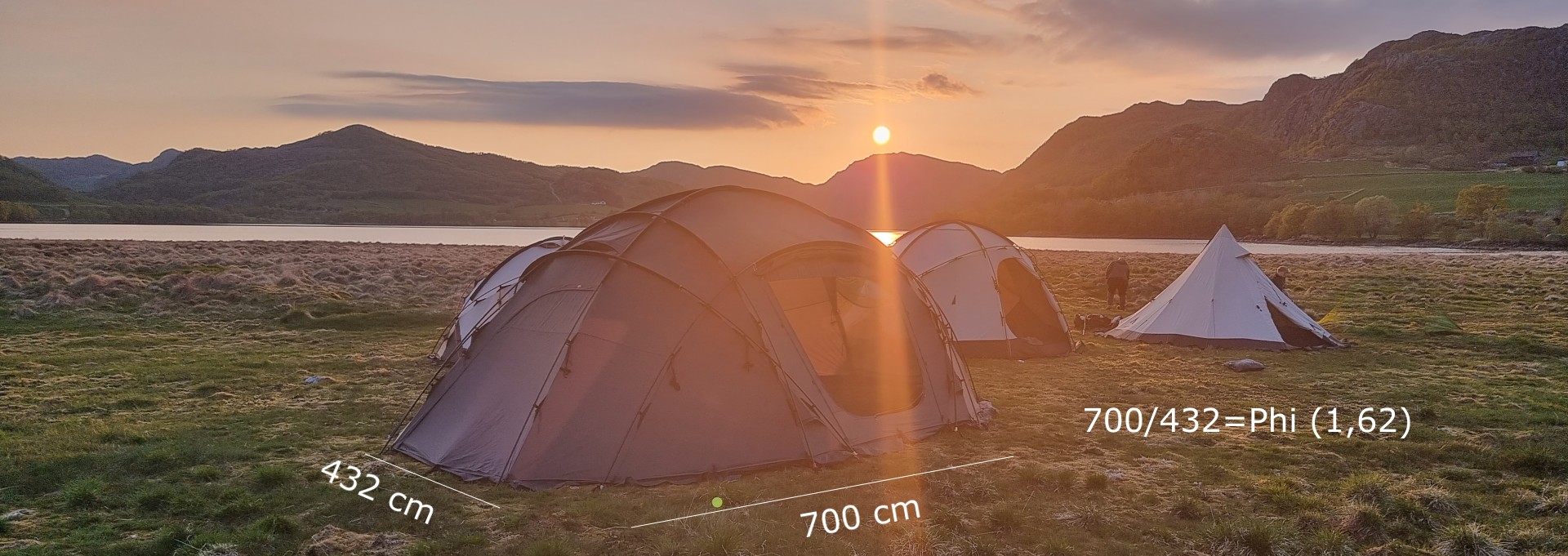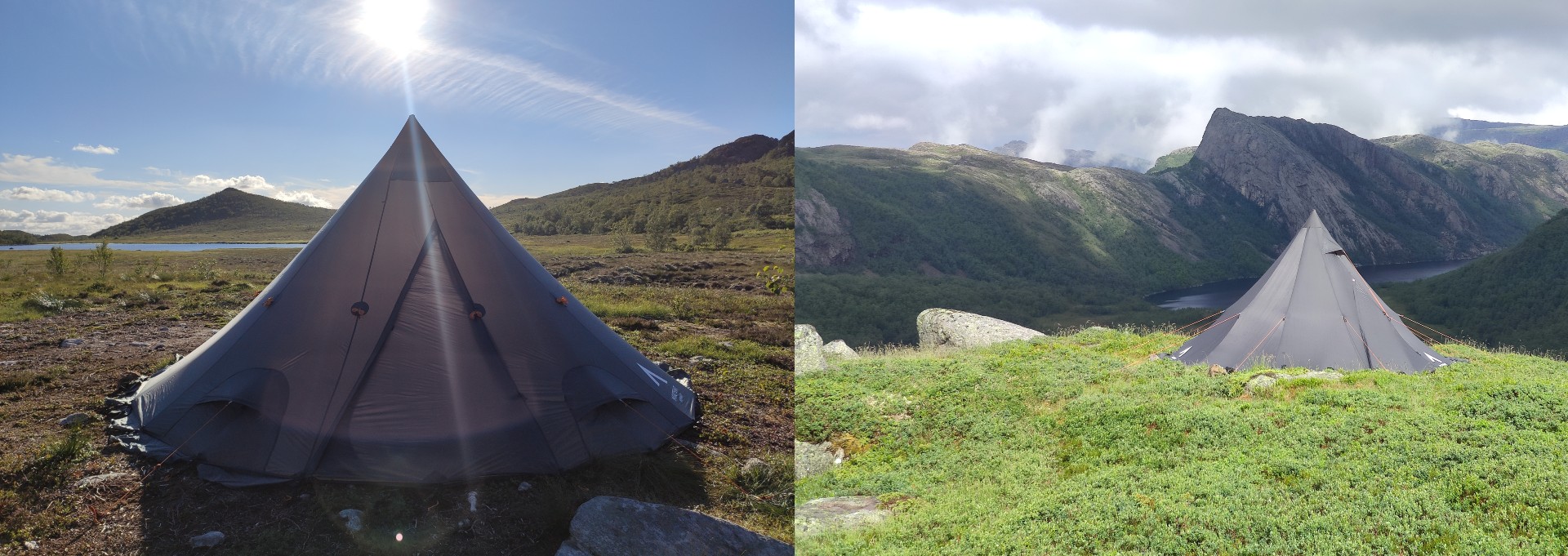Nature's Equation

Welcome to the world of NORTENT, where the beauty of nature meets the precision of mathematics in crafting exceptional products.
At the core of our journey is Kjetil, whose time in the military amidst the stunning landscapes of northern Norway ignited a profound love for the outdoors. As he stood guard, nature's wonders captured his imagination, and he began to appreciate the elegant language of science that underlies it all.
Kjetil's background as a teacher of mathematics and science further deepened his admiration for nature's hidden patterns – the captivating geometrics and fractals that bring harmony to our surroundings.
Phi- The golden ratio

The Golden ratio, with its fascinating value of 1.62, particularly fascinated him, as it appears in everything from sunflowers to galaxies, showcasing nature's innate balance.
-
Nautilus Shells: The nautilus shell is a classic example of the golden ratio in nature. If you examine the spiral pattern of the shell, you'll find that the ratio of each chamber's dimensions to the next one forms the golden ratio. This creates a visually striking and harmonious structure.
-
Sunflowers: The seeds of a sunflower are arranged in a spiral pattern, known as the Fibonacci spiral or the golden spiral. These spirals appear in both directions, with one set winding outward and the other inward. The number of spirals usually corresponds to two consecutive Fibonacci numbers (1, 2, 3, 5, 8, 13, etc.), which are closely related to the golden ratio.
-
Pinecones: Similar to sunflowers, the scales of a pinecone also follow the pattern of the golden spiral. As the pinecone grows, the new seeds are arranged in a manner that maximizes their packing efficiency while maintaining the golden ratio proportion.
-
Human Body: The human body exhibits several instances of the golden ratio. For example, the ratio of the length of your forearm to the length of your hand, from the wrist to the tip of the middle finger, is approximately the golden ratio. Additionally, the ratio of the height of a person's navel to their total height is also close to the golden ratio.
-
Hurricanes: The shape of hurricanes and cyclones often follows a spiral pattern, which can be approximated by the golden ratio. This can be observed when analyzing the radius of the storm's eye and its distance from the outer bands.
-
Galaxies: In spiral galaxies like the Milky Way, the arms follow logarithmic spirals, which are mathematically related to the golden spiral.
-
Bees and Honeycombs: Bees construct their honeycombs with cells arranged in a hexagonal pattern. The ratio of the diameter of one cell to the next is close to the golden ratio, ensuring an efficient use of space and minimal use of materials.
Cones

Cones are three-dimensional geometric shapes with a circular base that tapers to a single point at the apex. These structures can be found abundantly in nature, playing essential roles in various organisms and phenomena. Let's explore some examples of where we find cones in nature:
-
Pine Trees: One of the most iconic examples of cones in nature is the pine cone. Pine trees produce woody cones that protect and house their seeds. These cones open up when mature to release the seeds, contributing to the tree's reproductive cycle.
-
Flowers: Certain flowers exhibit cone-like structures. For instance, the female cone of the hop plant is used in brewing beer. The strobilus, a type of cone, can be found in certain flowering plants and ferns.
-
Volcanoes: Volcanoes, particularly composite volcanoes, often have a cone-shaped appearance. The layers of ash, lava, and other materials accumulate over time, forming the characteristic conical structure.
-
Snail Shells: Many types of snails have spiral-shaped shells, which can be approximated as cone shapes. These shells provide protection and shelter for the snail as it grows.
-
Certain Seashells: Some marine creatures, like the conch and sundial shells, exhibit a conical shape. These shells often serve as protective homes for the animals living inside.
-
Whelk Egg Cases: The egg cases of certain marine snails, such as whelks, have a conical shape. These structures protect the eggs until they are ready to hatch.
-
Tornadoes: While not solid structures, tornadoes have a conical appearance. The rotating column of air narrows towards the ground, creating a characteristic funnel shape.
-
Certain Fruits: Some fruits, like the fir cone galls found on oak trees, resemble small cones.
Nature's use of the cone shape demonstrates its effectiveness in various biological and physical processes, such as seed dispersal, protection, and efficient space utilization. Whether in the form of trees, seashells, or natural phenomena like volcanoes and tornadoes, cones can be observed in numerous aspects of the natural world.
Triangles

Triangles are one of the most basic and fundamental shapes found in nature. A triangle is a polygon with three sides and three angles, and its inherent stability and simplicity make it a prevalent shape in various living organisms and natural phenomena. Let's explore some examples of where we find triangles in nature:
-
Crystals: Many minerals form in crystalline structures, such as quartz and pyrite, where atoms are arranged in repeating patterns that often create triangular shapes.
-
Pyramids of Insects: Insects like ants and termites construct complex structures, such as anthills and termite mounds, which often have a triangular cross-section for stability and support.
-
Leaves: The arrangement of leaves on some plants forms triangular patterns. For example, the leaves of the sycamore tree are often arranged in a triangular shape.
-
Shark and Dolphin Fins: The dorsal fins of sharks and dolphins are often triangular in shape, providing stability and helping them maneuver through water efficiently.
-
Bird Beaks: The beaks of some bird species, like pelicans and herons, form triangular shapes, allowing them to grasp and consume their prey effectively.
-
Caterpillar Prolegs: The caterpillar's body is segmented, and between these segments, small fleshy structures called prolegs are present. These prolegs often form a triangular pattern along the caterpillar's body.
-
Mountains and Valleys: The contour lines on topographic maps represent changes in elevation, and the patterns often form triangles in mountainous areas and V-shaped valleys.
-
Wings of Birds: The wings of birds often have triangular shapes, which allow for effective aerodynamics and efficient movement through air and water.
-
Dewdrops on Leaves: When dewdrops form on leaves, they often gather at the tips, forming triangular patterns.
-
Honeycomb Cells: The hexagonal cells in a honeycomb are created by the arrangement of triangular surfaces, maximizing space and efficiency in the hive.
These examples demonstrate the prevalence and significance of triangles in nature. This simple yet stable shape is used by various living organisms to optimize their structures and function efficiently in their environments. Triangles are a reminder of the beauty and elegance of basic geometric shapes found throughout the natural world.
Dome/ spheres

Dome-shaped structures are common in nature, as this shape offers stability, strength, and efficient distribution of forces. These rounded, often hemispherical, structures can be found in various living organisms and natural phenomena. Here are some examples of where we find dome shapes in nature:
-
Hills and Mountains: Many hills and smaller mountains have dome-like shapes, especially when they are eroded or formed by volcanic activity. These rounded formations result from the gradual accumulation and displacement of rocks and sediments over time.
-
Caves and Grottoes: Some caves and grottoes feature dome-shaped ceilings formed by natural processes like erosion, dissolution of limestone by water, or volcanic activity.
-
Bubble Nests of Fish: Certain fish species, like the Siamese fighting fish, create bubble nests on the water's surface during breeding. These nests have a dome-like structure made of bubbles to protect the eggs.
-
Spider Webs: Some spiders, like the orb-weaving spiders, construct their webs in a dome shape. The web's radial threads create a frame that gives the structure its rounded appearance.
-
Honeybee Hives: Beehives are often composed of hexagonal cells, but when clustered together, they form a domed structure that houses the hive and stores honey and larvae.
-
Ant Hills: Many ant colonies build their nests in the form of dome-shaped mounds. These mounds provide protection and stability for the colony.
-
Mushroom Caps: The fruiting bodies of certain mushrooms, known as caps, often have a dome-like shape. This structure helps protect the mushroom's spore-producing gills or pores underneath.
-
Nest of Some Birds: Certain bird species build nests with a dome shape, providing a protective covering for their eggs and chicks. For example, the weaver birds construct intricate dome nests woven from grass and leaves.
-
Skull: In vertebrates, the cranial cavity of the skull has a dome shape, providing protection for the brain.
-
Sea Urchins: Some species of sea urchins have a dome-shaped shell (the hard outer shell), which offers protection and support.
-
Coral Domes: Coral reefs can form large dome structures due to the growth and accumulation of coral polyps over time.
-
Certain Plant Structures: Some plants, like certain cacti, have dome-shaped growth forms, which help them conserve water and protect against harsh environmental conditions.
Nature's use of the dome shape is both functional and aesthetically intriguing. From geological formations like hills and mountains to the intricacies of spider webs and beehives, dome structures play essential roles in the lives of various organisms and contribute to the captivating beauty of the natural world.
Circles

Circles are one of the most prevalent and fundamental shapes found in nature. A circle is a simple closed shape where all points on its boundary are equidistant from the center. This shape occurs abundantly in the natural world and plays a significant role in various biological, geological, and astronomical phenomena. Here are some examples of where we find circles in nature:
-
Planetary Orbits: The orbits of planets around the Sun are nearly circular. Although they can be slightly elliptical, the circle represents the simplest form of an orbit.
-
Celestial Bodies: Many celestial bodies, such as the Moon, the Sun, and other stars, appear as perfect circles when observed from a distance.
-
Ripples in Water: When a stone is thrown into a pond, it creates circular ripples that propagate outward from the point of impact.
-
Tree Rings: The growth rings in the cross-section of a tree trunk form concentric circles, reflecting its annual growth patterns.
-
Eyes of Some Animals: The pupils of certain animals, like cats and many other predators, form circular shapes that help control the amount of light entering the eye.
-
Flower Heads: The heads of some flowers, such as daisies and sunflowers, consist of a central circular disk surrounded by smaller petals.
-
Fruits: Many fruits, like oranges, apples, and berries, are naturally circular in shape.
-
Spider Webs: The webs of some spider species have a circular pattern, with radial threads forming a central hub.
-
Nest Construction: Birds and other animals often build circular nests to protect and house their eggs and young.
-
Mushroom Caps: The caps of many mushrooms have a circular shape.
-
Bubbles: Soap bubbles and bubbles in liquids form spherical shapes, which are essentially circles in two dimensions.
-
Craters: Impact craters on the surface of the Moon, planets, and moons in our solar system often have circular shapes due to the impact's explosive energy.
-
Erosion Patterns: Certain geological formations, like circular depressions known as sinkholes, are created through erosion processes.
-
Tree Canopies: The canopy of a dense forest often appears as a circular pattern when viewed from above.
-
Rainbow: When a rainbow forms, it takes on a circular shape centered on the anti-solar point.
These examples demonstrate the prevalence of circles in nature, showcasing their significance in both living organisms and various natural phenomena. The circular shape often arises due to the balance of forces and energies involved in growth, structure, and environmental factors, resulting in beautiful and harmonious shapes throughout the natural world.
Fueled by a desire to create equipment that aligns seamlessly with nature, Kjetil embarked on designing the Lavvo and Gamme tents. Inspired by the wisdom of indigenous shelters, these tents combine the essence of tradition with modern innovation. The Lavvo's gentle cone shape and the Gamme's well-balanced circular design exemplify the perfect marriage of mathematical brilliance and natural aesthetics.
- The Gamme has a spherical shape and is a sphere split in two where the diameter is twice the size as the height. So no Golden ratio here as the sphere makes the "balance" in this tent.
- On the Lavvo we first had the golden ratio between the height and the diameter. But for this the height of the tent was a bit too low for a practical function inside the tent even though the tent looked good. So we adjusted the height a bit. The ratio today here is 1,88 between height and diameter. But the golden ratio was a starting point.
- Same goes with The Koie 7 where the two halves are a circle cut in half. But here is the golden ratio used as a starting point where the Length of the Koie 7 is the golden ratio x3. (1,618 x 3 = 485 cm)
- Vern 1 and 2 has the golden ratio between length and width (where the height then is half the length of the width for that perfect circle.
- Same goes for our upcoming Gamme Mjodhall. It also has the Golden ratio between length and width. (700/432=1,62). (The height of the two spheres in the tent are half the size as of the width presenting two perfect half circles)
At NORTENT, we hold the belief that nature is our ultimate home, and our products should reflect that connection. Each tent is thoughtfully crafted to be spacious, lightweight, and incredibly easy to set up, echoing nature's own efficiency and simplicity.
As you venture into the great outdoors – exploring majestic mountains and serene forests – our tents become your reliable companions, providing a sense of security while seamlessly blending with the beauty of nature. Beyond practicality, they possess an understated charm that complements the breathtaking landscapes around you.
Embrace the harmony of nature and mathematics as you embark on unforgettable adventures with NORTENT. Our tents embody the perfect blend of science and passion, enabling you to answer nature's call with confidence and wonder. Experience the magic of NORTENT and let nature be your guide to new horizons.














